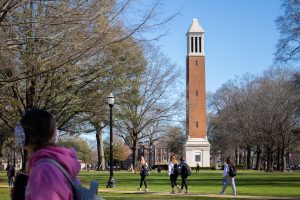Opinion | Not enough people know about Alabama’s prison crisis
April 16, 2023
Editor’s Note (4/17/2023): This story has been updated to correctly list Caddell Construction Company as building a new prison.
As death after death occurs, it is evident that incarceration in Alabama is becoming a death sentence instead of being used for rehabilitation. On top of the rising death toll, Governor Kay Ivey wants to use $100 million dollars out of Alabama’s school funds to build two new ‘megaprisons’ in rural Alabama.
But the humanitarian crisis and deep seeded corruption in Alabama’s prison system is not something you would find in national headlines. Even the United States Department of Justice still can’t unravel the corruption and violence in our prison system due to the unreliable reports from the Alabama Department of Corrections.
Too few Alabamians fully understand the injustices happening in our prison system; in fact the full extent of the crisis has barely made local or national news. Prisons are meant to rehabilitate inmates for them to return into society as positive contributing citizens. But that is not what is happening in Alabama’s prison system.
Unprecedented amounts of death in Alabama prisons
You would think more Alabamians would have heard that four incarcerated individuals have died every week in Alabama prisons just in March, with the same numbers repeated in January and February and trending towards that way in April.
According to Alabama Appleseed, the Alabama Department of Corrections recorded a historic 266 fatalities in state run facilities in 2022.
The prison crisis has gotten so bad that the parole board is “accidently” denying parole to dead individuals and, to many, this comes as no surprise.
“The ADOC does not consistently inform Alabama families when their incarcerated loved ones pass away,” said Carla Crowder, executive director of Alabama Appleseed. Death after death, incarcerated individuals have been found in their beds “unresponsive” and pronounced dead with little investigation into how their deaths occurred.
Housing units in these facilities are dormitory style, which are essentially enormous halls with bunk beds lined up as close as they can fit. On top of the overcrowding issue where many prisoners are forced to sleep on floors, people can get easily agitated, leading to violence.
In combination with low staffing, large units like these may go unguarded for extended periods of times, sometimes even entire staff shifts.
United States Department of Justice 2020 prison lawsuit
In 2020, under the Trump Administration, the Department of Justice sued the state of Alabama and the Department of Corrections for the inhumane conditions in state facilities and a rising death toll in the prisons.
According to the DOJ lawsuit, the Alabama Department of Corrections has “repeatedly failed to take reasonable measures to prevent security staff from inflicting serious harm on prisoners.”
The DOJ also noted that the facilities “held 6,000 prisoners over their designed capacity. The severe and pervasive overcrowding increases tensions and escalates episodes of violence between prisoners, which lead to uses of force.”
The use of excessive force in Alabama’s prisons is far too common. In December 2018, a correctional officer violently beat a handcuffed prisoner with a baton in the Ventress medical unit. The prisoner did not antagonize the officer before the beating and his hands were cuffed behind his back.
During the beating, all four of the nurses heard the officer yell something to the effect of, “I am the reaper of death, now say my name!” The prisoner begged the officer to kill him. In almost all of the reported incidents of excessive force, little to no discipline was imposed on the correctional officers.
Alabama has a history of being condemned by the federal courts and the United States Department of Justice for the unconstitutional treatment of Alabama prisoners. In 1976, four men’s prisons and one women’s prison held a population of over 5,000 inmates even though the facilities were only designed to hold 2,000 and the DOJ found constitutional deficiencies in 11 different areas, resulting in a 13 year federal takeover of Alabama’s prisons.
In the 2020 lawsuit against the Alabama Department of Corrections, the judge’s findings almost exactly align with what the DOJ’s in the last few years.
The DOJ is currently investigating the entire prison system for men, where despite the ADOC being put on notice in 2020, conditions worsened with low staffing levels, an escalation in violence and prisoner deaths, and overcrowding.
The state’s only solution to both lawsuits is opening new prisons.
Parole Denials
In Alabama prisons, 97% of people considered for parole from January to March 2023 were denied. These decisions have been made by three members of the Board of Pardons and Paroles.
On top of that, more than 5,000 people are serving sentences of life or life without parole.
The high denial rate increased in 2019 when Gov. Kay Ivey and Attorney General Steve Marshall gave the Board Chair, Leigh Gwanthney, a mandate to stop granting parole. In the 12,000 parole hearings she has presided over since her appointment, the board denied parole to nine out of every 10 people even though over 80% of people denied met the current eligibility requirements for parole.
Matthew Bailey , an attorney, has found that getting his clients to be granted parole has been a coin toss, even if they had already met the board’s eligibility requirements.
“Certain of my clients are being released more often and it’s reflected in the demographics of who is being granted parole and who isn’t being granted parole,” said Bailey in an Oct. 2022 article for the Alabama Political Reporter.
In 2021, the legislature approved a $1.3 billion dollar expansion to build two new men’s prisons in Elmore and Escambia counties. Alabama has the worst prisons in the country, and building more of them won’t fix that.
Legislative leadership has acknowledged the new prisons would not relieve overcrowding; they would only replace old facilities that state leaders failed to maintain over the last four decades.
With Alabama prisons already unconstitutionally overcrowded, it is hard not to beg the question if Attorney General Steve Marshall is pushing to keep Alabama prisons overcrowded by pushing for the opening of the new 4000 bed mega prison built by Caddell Construction Company.
The incarcerated deserve a second chance. They deserve the right to live, to change their ways and to try again.
Alabama prisons are a death sentence and corruption runs rampant across all levels of the system with inmates being profited off of, then discarded by every individual involved. There are ways to change the system, but we, as students, Alabamians and humans, have to show that we care and believe that everyone deserves a second chance at life.
Prison reform advocates have mobilized across Alabama and you can get involved with various student organizations. Tide Against Time is a student organization run by senior Kaila Pouncy, working to educate individuals about the effects of mass incarceration and spreading awareness around Alabama’s Prison Crisis. Another organization, Alabama Students Against Prisons, is helping bring awareness to the prison crisis and mobilizing students across the state. Since 2021, they have advocated for incarcerated individuals’ families and rallied for prison reform.
Young people can and have made a difference. It’s time to reform Alabama’s prison system.










